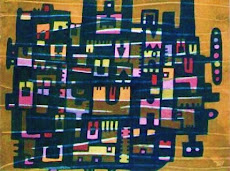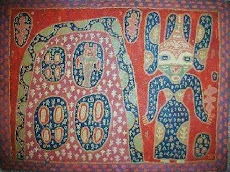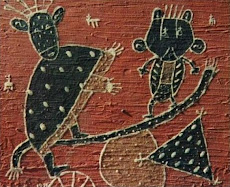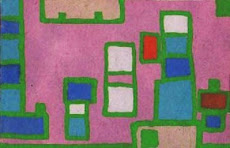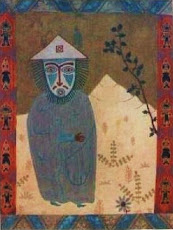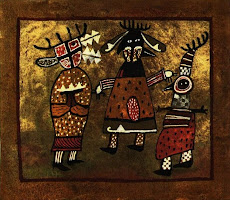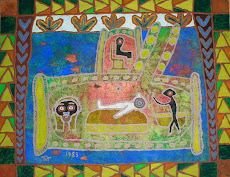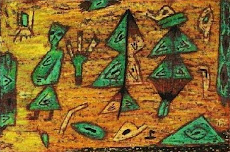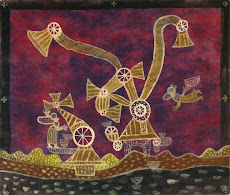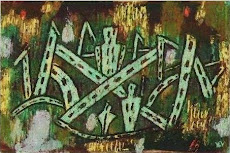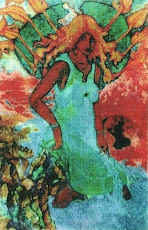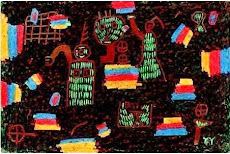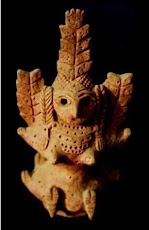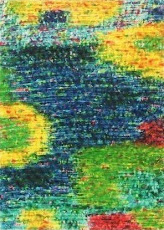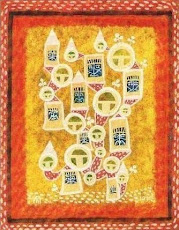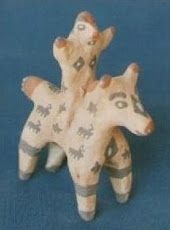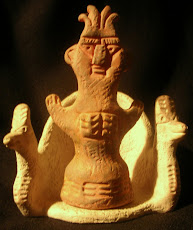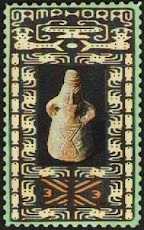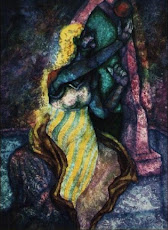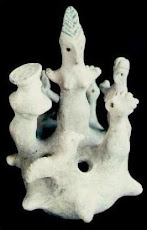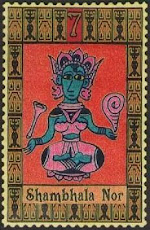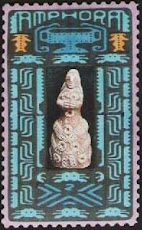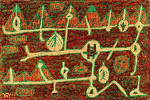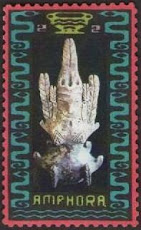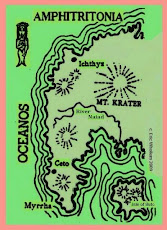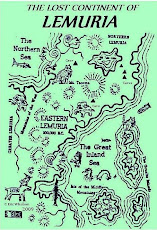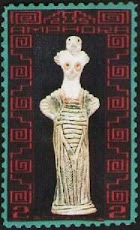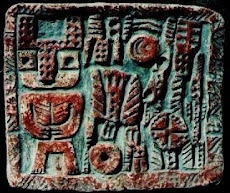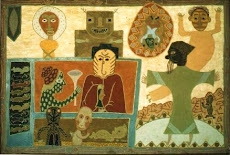Light of the Mother and Son
1984
by Eric Whollem
mixed media on paper
9" x 6"
COPYRIGHT BY THE ARTIST
Concow Maidu Influences in Modern Art
I lived as close neighbors to Concow Maidu Indians from Northern
California off and on for 35 years. It is no surprise that their culture
greatly influenced the style and themes of much of my art.
The painting above is filled with pictographic icons that derive from
California Native American rock art: pictographs and petroglyphs.
The Maidu have a few traditional sites where such imagery appears.
I was shown some Mountain Maidu petroglyphs near Susanville by
Adrian Smith, former head of the Butte County Tribal Council. Many of
these were damaged by vandalism. I found a stone with concentric
engravings near Milsap Bar along the Middle Fork of the Feather River.
This stone was near what appeared to be a large and perfect fishing
hole. Maidu petroglyphs are also found on Table Mountain above
Oroville, but are extremely hard to locate. But the images are recorded
in Heizer's book on California rock art.
THE SACREDNESS OF THE MOTHER
I was shown some Mountain Maidu petroglyphs near Susanville by
Adrian Smith, former head of the Butte County Tribal Council. Many of
these were damaged by vandalism. I found a stone with concentric
engravings near Milsap Bar along the Middle Fork of the Feather River.
This stone was near what appeared to be a large and perfect fishing
hole. Maidu petroglyphs are also found on Table Mountain above
Oroville, but are extremely hard to locate. But the images are recorded
in Heizer's book on California rock art.
CONCOW MAIDU Video by E. Whollem
THE SACREDNESS OF THE MOTHER
This painting deals with the Mother concept, the title being, 'Light
of the Mother and Son.'
There is much traditional lore that deals with the sacredness of the
Mother Principle. For example, just beyond Little Bald Rock in
Butte County, is a large granite dome that is called Oost Ho, which
means literally 'Belly Rock.' This dome is conceived as the pregnant
form of a great Goddess or female creative spirit.
EARTH PAINTS
EARTH PAINTS
In 1973 I began to make paints from raw materials. The Maidu
made earth paints, as well as paints from pollen and acorn meal
in the old days. They are known to have traded a green earth
pigment to tribes across the Sacramento Valley in the Coast Range.
Earth paints have been traditionally used as body paints in dance.
EARTH PAINTINGS Video by E. Whollem
PICTOGRAPHS AND PETROGLYPHS IN MODERN MAIDU ART
Earth paints have been traditionally used as body paints in dance.
EARTH PAINTINGS Video by E. Whollem
PICTOGRAPHS AND PETROGLYPHS IN MODERN MAIDU ART
Contemporary Maidu artists such as the Harry Fonseca have
delved into modern abstract art with interpretations of pictographic
iconography. See the links below to find a very interesting interview
with Fonseca. Fonseca was of Nisenan, or Southern Maidu, ancestry.
My contacts among the Maidu have been with the Maidu of Butte
County~the Concow Maidu. See my links below to read more about
my friends and associates~mostly from the Feather Falls and Berry
Creek peoples. The Concow Maidu are referred to as the West People.
Fonseca's pictographic work appears to be imbued with iconography
akin to Great Basin and Southwest Native American rock art. The
styles of California rock art are generally less figurative and more
abstract--with notable exceptions. . .such as the prevalent big horn
sheep images found in Eastern Sierra rock art. Fonseca, long an
inhabitant of the Southwest, nevertheless was greatly influenced by
the Eastern Sierra petroglyphs near Owens Lake in California. Many
images of the big horn sheep are found in that area. Owens Lake is
located south of traditional Maidu territory.
I have also delved into the arts of Utah and the Southwest, but I have
tried to add a Californian flavor to my designs. I was originally
inspired as an art student by the Navajo sandpaintings of David
Villasenor.
My own pictographic designs have incorporated elements from
such California Native American groups as the Chumash and the
Modoc, and other Sierra Nevada rock art beyond the the localities
where the various Maidu peoples have their native territory. The
Sacramento Valley, Sierra Foothills, and the northern Sierra Nevada
mountains are the areas of the Maidu. In these areas the rock art is
highly abstract. Heizer's ethnographic transcriptions of prehistoric
California rock art has long been a major guide to my studies.
Pictographic imagery appears in Maidu basketry however and has some
figurative elements such as the wuh-wuh form, which is the triangle
which represents Koi, the sacred Goose, the bird of Heaven.
Artists must rely upon imagination to recreate or create mythological
images. . . especially in areas where the traditional vocabulary of
visual icons is sparse. This has been the case with the Nisenan artist,
Fonseca, as well as myself, an initiate of the esoteric lore of the Concow
Maidu.
I created a video called 'The Ghost Oak' with Russ Dunn as well as
Adrian Smith of the Butte County Tribal Council. This animation
told the story of the destruction of the giant sacred mother oak tree
that used to stand in Durham, California, just south of Chico. It was
said that seven kinds of acorns grew on that tree~now cut down for
firewood.
with Fonseca. Fonseca was of Nisenan, or Southern Maidu, ancestry.
My contacts among the Maidu have been with the Maidu of Butte
County~the Concow Maidu. See my links below to read more about
my friends and associates~mostly from the Feather Falls and Berry
Creek peoples. The Concow Maidu are referred to as the West People.
Fonseca's pictographic work appears to be imbued with iconography
akin to Great Basin and Southwest Native American rock art. The
styles of California rock art are generally less figurative and more
abstract--with notable exceptions. . .such as the prevalent big horn
sheep images found in Eastern Sierra rock art. Fonseca, long an
inhabitant of the Southwest, nevertheless was greatly influenced by
the Eastern Sierra petroglyphs near Owens Lake in California. Many
images of the big horn sheep are found in that area. Owens Lake is
located south of traditional Maidu territory.
I have also delved into the arts of Utah and the Southwest, but I have
tried to add a Californian flavor to my designs. I was originally
inspired as an art student by the Navajo sandpaintings of David
Villasenor.
My own pictographic designs have incorporated elements from
such California Native American groups as the Chumash and the
Modoc, and other Sierra Nevada rock art beyond the the localities
where the various Maidu peoples have their native territory. The
Sacramento Valley, Sierra Foothills, and the northern Sierra Nevada
mountains are the areas of the Maidu. In these areas the rock art is
highly abstract. Heizer's ethnographic transcriptions of prehistoric
California rock art has long been a major guide to my studies.
PICTOGRAPHIC ART Video by E. Whollem
Pictographic imagery appears in Maidu basketry however and has some
figurative elements such as the wuh-wuh form, which is the triangle
which represents Koi, the sacred Goose, the bird of Heaven.
Artists must rely upon imagination to recreate or create mythological
images. . . especially in areas where the traditional vocabulary of
visual icons is sparse. This has been the case with the Nisenan artist,
Fonseca, as well as myself, an initiate of the esoteric lore of the Concow
Maidu.
I created a video called 'The Ghost Oak' with Russ Dunn as well as
Adrian Smith of the Butte County Tribal Council. This animation
told the story of the destruction of the giant sacred mother oak tree
that used to stand in Durham, California, just south of Chico. It was
said that seven kinds of acorns grew on that tree~now cut down for
firewood.
________________
See more of my posts that deal with the MAIDU INDIANS on this link:
http://artblogericwhollem.blogspot.com/search/label/maidu%20indians
See a very informative interview with HARRY FONSECA on this link:
http://www.britesites,com/native_artist_interviews/hfonseca.htm
If this link is broken, try a Google Search for the site.
Also check out HARRY FONSECA on:
http://www.harryfonseca.com
See a very informative interview with HARRY FONSECA on this link:
http://www.britesites,com/native_artist_interviews/hfonseca.htm
If this link is broken, try a Google Search for the site.
Also check out HARRY FONSECA on:
http://www.harryfonseca.com
See more of my FIGURATIVE ABSTRACTIONS here:
Readers interested in my approaches to EARTH PAINTS should see these posts:
*
















